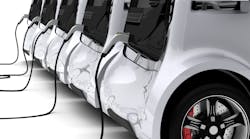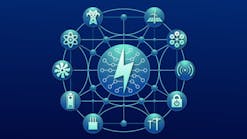Series Introduction—Part 1
In this first installment of a two-part series focusing on the electric fleet power play, Black & Veatch electrification experts address the scope of opportunities and challenges that migrating to an electrified future hold. This is based on the Black & Veatch electric fleet power play LinkedIn Live event
###
Climate change policy, decarbonization and sustainability goals are driving the global push towards electrification, backed by rapid advancements in technology. This push also provides opportunities for companies to meet their objective of greater control over energy investments and cost certainty.
The rise in fleet electrification begs a few questions: Will the power supply be ready when the vehicles are? What will it cost utilities to expand service? What happens if the power goes out? With experts predicting hundreds of millions of EVs on the roadways within the next 10 to 20 years, the infrastructure needs to support this conversion are massive, and access to electricity could grow more competitive.
Utilities and energy companies alike have an opportunity to help drive zero-emission vehicle adoption and to start preparing now for an electric future. Advance planning for everything from site selection considerations to power requirements as well as future scalability and resiliency will lead to cost-efficient, sustainable programs.
Market Drivers
What is driving the market for fleet electrification? Economics? The grid? The short answer is that it depends on the operation’s location.
In London, for example, it can cost up to £100 per day to take a non-compliant vehicle into the city’s ultra-low emission zone, while New York is moving towards carbon and emissions pricing. In California, the advanced truck ruling — which mandates that manufacturers who certify Class 2b-8 chassis or complete vehicles with combustion engines would be required to sell zero-emission trucks as an increasing percentage of their annual California sales — starts in 2024. This means that by 2035, zero-emission truck/chassis sales would need to be 55% of Class 2b-3 truck sales, 75% of Class 4-8 straight truck sales and 40% of truck-tractor sales.
Smart fleet owners are planning their approach to ensure compliance with regional and national government regulations, as well as corporate mandates. At some point, fleets that don’t electrify will start losing money while their electrification-minded competitors realize cost savings. This will be especially important for public fleets funded by taxpayers. Fleet owners should start watching for pivot points in each market so they can maximize operational savings by proper timing of infrastructure upgrades.
As customers look to electrify fleets, competition for electrons will be a key consideration. Current utility infrastructure provides a finite amount of electricity to an area, and as multiple customers in that area request new capacity, utilities will often be required to complete upgrades to meet this demand. Capacity constraints are highly localized challenges for utilities — where you are connecting your fleet will determine what type of utility upgrade will be required.
Utility upgrade implementation paths take different time commitments depending on the improvements that need to be made to increase electric capacity in an area. For example, electrifying vans might just need one additional megawatt from the utility, perhaps requiring an infrastructure upgrade of a service transformer, which would take a few months to complete. Medium- and larger-duty vehicles might require an upgrade of five megawatts, meaning the utility may have to upgrade distribution lines coming from the substation to the charging site — a remedy that could take up to a year. A very large-scale, heavy-duty fleet electrification of 20 MW could require adding a substation or doing significant upgrades to existing substation equipment — work that could take two years or more.
Not all electrons cost the same. The early adopters into the market — the first ones to request capacity from the utility and get those charges in place — are going to secure the cheapest electrons. Once that capacity is gone and the utility starts building new poles, wires and substations, the cost will rise.
The Cost of Charging
The expansion of EVs remains hindered by the limits of today’s charging infrastructure that is now woefully insignificant when considering the extent of the network needed. Eager to address this challenge, President Biden’s proposed infrastructure spending legislation allocates US$7.5 billion for electric vehicle charging stations that highlight a focus on connecting rural and disadvantaged communities. An additional US$73 billion is planned to build a more robust electric grid that helps facilitate the expansion of renewable energy.
While that outlay appears impressive, such spending remains only a drop in the bucket when analyzing the full cost of expanding EV charging infrastructure. Fleet operators commonly ask, “What is it going to cost to fuel my fleet with electricity?” For electricity alone, the math is simple: utilities can compare the diesel costs relative to the electric costs — but the actual charging infrastructure cost remains a big unknown.
Operators of a typical fleet spend staggering amounts of money on gasoline and diesel fuel — by some accounts, close to US$1 billion a day. For perspective, approximately US$1 dollars a day is spent on electricity. Leveraging the higher efficiency of EVs and flexible electrons opens the opportunity to dramatically increase electrification while reducing operating costs. Utilities and energy providers can command a sizable percentage of this spending shift; however, they are not alone in the new ecosystem required to support this conversion.
For fleet owners looking to electrify, the big unknown – before they even perform a site assessment and wade into doing detailed design — is ascertaining the infrastructure price tag. For utilities and fleets – and the people looking to supply those services – the question comes down to the expense. There is opportunity for fleets to save money by electrifying – and for other stakeholders to profit by providing them services. This is especially true early in the process in jurisdictions that offer incentives – most notably in California, where low-carbon fuel credits, make-ready incentives and demand-charge holidays make that state a market stronghold due to positive business cases. Other markets are following closely behind.
On the heavy-duty side, more published pricing from truck makers would be beneficial. While the industry knows the price of the Tesla Semi, for instance, it would be helpful to see more publicly available pricing and specifications on the other semis. This would help fleet owners better formulate the business case around electrifying more of their heavy-duty fleets.
Changing Operations and Embracing Orchestration
While it’s refreshing to see charging orchestration come to electrification from other industries like data centers, several questions around protocol, design, installation and damage prevention continue to play out.
Preventing damage to charging equipment remains an issue that’s top of mind. A bollard that can stop an 80,000-pound semi-truck, for instance, is extremely expensive, leaving to question how many bollards would be required to protect the site’s charging equipment. Each market also has its own operational rules; public-use vehicles such as school buses or transit buses, for example, require dedicated operational workers to fuel the vehicle.
Standards also are a priority. There is vested interest in the technologies and protocols — e.g., solar, automotive, charging — that already are working. Owners should look at what already has been successfully integrated, end-to-end. Load management will require supporting a particular protocol with a specific utility; there are numerous possible choices along with potential chaos as fleets seek interoperability across their locations. Clearly, industry and utilities will need to come to a consensus.
To scale successfully, protocols should be standardized across the industry and not customized to every site. If protocols are proprietary or too fragmented, the network will be too difficult to scale. An example: The California Energy Commission is working on protocol stacks as it leads an effort to update the state's “vehicle-grid integration roadmap” to intermingle electric vehicle charging needs with those of the electrical grid. With Megawatt Charging System — an industry-led approach to heavy-duty charging for all types of transportation — on the horizon, the full range of standardized plugs and power levels are available for fleets to choose from based on their applications.
It’s also important to understand that the chargers are going to come with their charging management software, and the trucks are going to come with their truck package. Charging orchestration — the automation of tasks using process-driven workflows to replace repetitive, slow and error-prone manual tasks, making systems more efficient — provides a view of the entire fleet across different vehicle types. What's the price of charging going to be? How can the priciest electricity be avoided? We see a role for this sort of charging orchestration on top of the software that's in the chargers in the trucks. Black & Veatch’s clients increasingly have seen value in using charging orchestration software.
Resiliency
Building resiliency into the infrastructure plan to electrify your fleet is a critical step in ensuring reliable, consistent operations. Scores of emerging technologies allow owners to develop multiple paths to deliver electrons to the charging systems while providing additional revenue streams or the ability to manage not only energy for the fleet, but the total energy of their facility and operations.
This means taking a step back from simply looking at the impact of electrifying the fleet — and the costs and benefits for just the fleet components — to look at the entire operation. Are there ways to utilize greener technologies — for example, solar, storage, hydrogen — to meet corporate sustainability or decarbonization goals while also allowing those technologies to provide critical operation resiliency?
Fleet owners will also be dealing with different partners, and likely altering their relationship with the electric utility. Before electrification considerations, interaction with the electric utility may have been as casual as simply paying the bill. Electrification requires forming a deeper partnership and working with the utility to meet power delivery timelines and to understand the full cost of energy. It may also mean ensuring that capacity and resiliency can be augmented or supplemented with other technologies or services provided by the market. There is an opportunity for utilities to collaborate with others in the market in new and interesting ways to create and deliver a total solution.
Without question, the benefits of expanding electric vehicle charging are limitless and replete with opportunities. Building a business case and future-proofing your technology and system design are two of the more complex aspects of fleet electrification we’ll explore in Part 2: The Electric Fleet Power Play.





